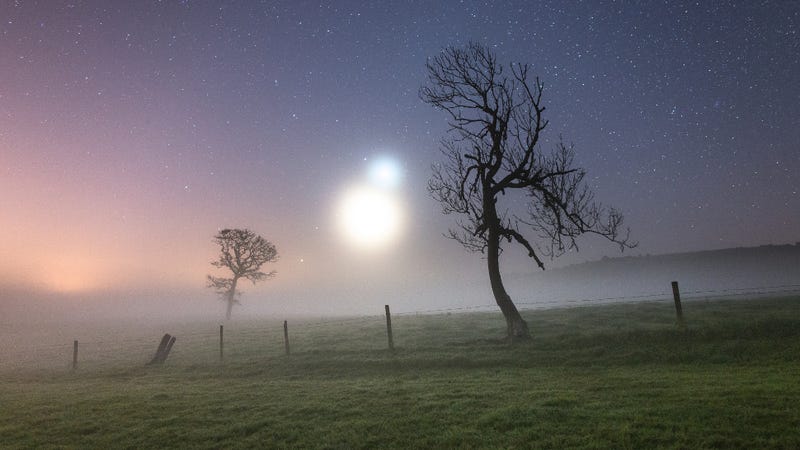The Best Astronomy Images of 2016 Are Truly Out of This World.

The winners of the annual Insight Astronomy Photographer of the Year have been announced. From eerie eclipses through to battered lunar landscapes, these images are an absolute treat.
The Insight Astronomy Photographer of the Year is run by the Royal Observatory Greenwich. Now in its eighth year, the competition received an unprecedented 4,500 entries from over 80 countries. Here are the winning images, along with the runner's up, for each category.
Overall Winner: Baily's Beads, Yu Jun

China's Yu Jun captured the "Baily's Beads" effect during the total solar eclipse of March 9, 2016, as seen from Luwuk, Indonesia. As the Moon passes in front of the sun, its surface allows beads of sunlight to escape in some places and not in others. Yun captured the different beads of sunlight that leak from behind the Moon throughout the eclipse and stacked them on top of one another to create this unusual pic.
Winner of Aurorae: Twilight Aurora, György Soponyai

A stunning Aurora Borealis as seen above the Adventtoppen Mountain in Norway.
Winner of Galaxies: M94: Deep Space Halo, Nicolas Outters

Messier 94, or M94, is a distant spiral galaxy lying approximately 16 million lightyears away from our planet. The shimmering pinks of the inner ring show the hectic star forming activity leading to the term "starburst ring." Photographer Nicolas Outters also captured the often unseen galactic halo of M94 made up of stars, hot gases and dark matter.
Winner of Our Moon: From Maurolycus to Moretus, Jordi Delpeix Borrell

An incredibly close-up view of the battered lunar landscape littered with craters forged by impacts from meteors and asteroids.
Winner of Planets, Comets & Asteroids: Serene Saturn, Damian Peach

This stunning photograph depicts Saturn's famed rings in great detail with striking contrast between each of them. Storms are visible across the face of the planet, as well as the astronomical mystery that is the hexagon at Saturn's north pole.
Winner of Skyscapes: Binary Haze, Ainsley Bennett

A misty morning on the Isle of Wight is the setting for this image resembling an eerie scene from a science fiction film. The obscuring weather actually accentuated the brightness of Venus and the crescent Moon and transformed them to appear as glowing orbs floating over the countryside.
Wiiner of Stars & Nebulae: The Rainbow Star, Steve Brown

Sirius is the brightest star in the night sky, and it's often seen shining as a white star. But it's also known to flash with hues of numerous colors, the result of turbulence in the Earth's atmosphere. Photographer Steve Brown had been searching for the best way to display these colors in an image, and he finally hit upon the idea of videoing the star, then picking out the frames with the most striking colors to showcase the chameleon-like quality of the star.
Winner of Young Photogapher (Under 15): Lunar Reversal, Brendan Devine

A truly innovative, high-contrast image of the Moon that's been inverted to bring out the intricate details of the rugged, lunar landscape that we often miss in more traditional shots of our natural satellite.
Winner of Best Newcomer: Large Magellanic Cloud, Carlos Fairbairn

A gorgeous images of the Milky Way's satellite galaxy and close neighbor, the Large Magellanic Cloud.
Winner of Robotic Scope: Iridis, Robert Smith

This composite image compares the slitless spectroscopy of two planetary nebulae—the Cat's Eye Nebula at the top, and the Ring Nebula below.
Runner Up, Our Sun: Sun Flower Corona, Catalin Beldea and Alson Wong

A composite of 12 images taken during the total solar eclipse on March 9, 2016 from Tidore Island in Eastern Indonesia.
Runner Up, Aurorae: Black and White Aurora, Kolbein Svensson

An unconventional view of the aurora, simply in black and white. The removal of the vivid colors so commonly associated with the Northern Lights brings out the fluidity of the aurora and the stark contrast it forms against the night sky.
Runner Up, Galaxies: Towards the Small Magellanic Cloud, Ignacio Diaz Bobillo

The Small Magellanic Cloud is seen on the left hand side of the image in a flurry of blues and pinks that illustrate the several hundred million stars contained within the dwarf galaxy. The globular cluster, 47 Tucanae, is seen glowing a vibrant orange, in the upper right corner of the photograph.
Runner Up, Our Moon: Rise Lunation, Katherine Young

This shot of the moon, captured at 98 percent illumination, looks like it comes from a Pink Floyd album cover.
Runner Up, Planets, Comets & Asteroids: Comet Catalina, Gerald Rhemann

Comet Catalina leaves a dust trail in its wake. A second tail of ionized gas emanates from its luminous blue coma, fades into the darkness.
Runner Up, Skyscape: Silent Waves of the Sky: Noctilucent Clouds, Mikko Silvola

A close up view of of noctilucent clouds formed in the skies over Finland. Also known as night clouds, they're composed of crystals of water ice and are the highest clouds in Earth's atmosphere, but they can only be viewed when the sun is below the horizon but they are still in the sunlight.
Runner Up, Stars & Nebulae: Perseus Molecular Cloud, Pavel Pech

The Perseus Molecular Cloud lies 600 light years from our planet, and it's home to a large number of deep sky objects, the most famous of which is NGC1333 in the top right part of the image, radiating a vivid blue.
Runner Up, Young Photographer: What the City Does Not Show You, Jasmin Villalobos

A man stands on a hill on Canyon Lake, Arizona, silhouetted against a night sky that fades from the moody, blue light pollution seen on the right hand side to the darkness that hangs over the desert.
[Royal Museums Greenwich]
Random image that no relation with the story above
Source Here
Random image credited to www.clipartbest.com









